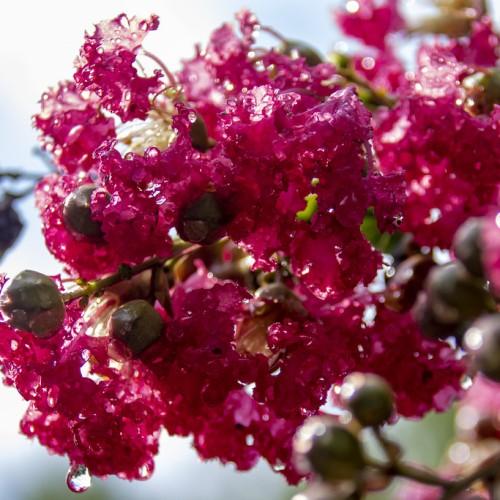
crape myrtle
Lagerstroemia indica 'Watermelon Red'
Cycle:
Perennial
Watering:
Average
Hardiness Zone:
6 - 9
Flowers:
Flowers
Sun:
Full sun
Leaf:
Yes
Growth Rate:
Low
Maintenance:
Moderate
Salt Tolerant:
Yes
Care Level:
Medium
watering
Crape myrtle (Lagerstroemia indica 'Watermelon Red') should be watered deeply 1-2 times a week depending on the soil type and weather. During the hottest months of the year, water deeply every 5-7 days. Be sure to water the root zone directly at the base of the plant rather than from above to limit the risk of fungal diseases. In areas of extreme heat or drought, watering may need to be increased to 3-4 times per week. However, it is important to not over-water the plant or runoff will occur. To check for proper watering, probe the soil 2-3 inches from the main stem with your finger. If the soil feels dry then watering is necessary.
sunlight
Crape myrtle (Lagerstroemia indica 'Watermelon Red') thrives when it receives 6-8 hours of full or lightly filtered direct sunlight each day. This species is particularly sensitive to the intensity of light, so while it may do well in more intense sun exposure, it is beneficial to avoid extended periods of direct, mid-day sunlight as it may burn the foliage. During the summer months when the days are longer, it is beneficial to provide some light after sundown as to not affect the flowering buds. While it prefers sunny locations, it will tolerate some shade as well.
pruning
Crape myrtles (Lagerstroemia indica "Watermelon Red") respond well to light pruning. It is best to prune your Crape Myrtle in late winter or early spring, just before its new growth appears. This will help to control its size and shape and will also encourage the formation of new shoots and blooms. Pruning can also eliminate dead or damaged branches. Begin by removing any dead or diseased branches, then reduce the height of large branches or the entire plant, if desired. Be sure to make your pruning cuts just above a leaf and at an angle in order to encourage new growth and a more even shape.
